
Mantis shrimp are carnivorous marine crustaceans of the order Stomatopoda. Stomatopods branched off from other members of the class Malacostraca around 400 million years ago. Mantis shrimp typically grow to around 10 cm (3.9 in) in length, while a few can reach up to 38 cm (15 in). A mantis shrimp's carapace covers only the rear part of the head and the first four segments of the thorax. Varieties range in colour from shades of brown to vivid colours, with more than 520 species of mantis shrimp known. They are among the most important predators in many shallow, tropical and subtropical marine habitats. However, despite being common, they are poorly understood, as many species spend most of their lives sheltering in burrows and holes.

The Chinese mantis is a species of mantis native to Asia and the nearby islands. In 1896, this species was accidentally introduced by a nursery tender at Mt. Airy near Philadelphia, United States. Tenodera sinensis often is erroneously referred to as Tenodera aridifolia sinensis because it was at first described as a subspecies of Tenodera aridifolia, but Tenodera sinensis is now established as a full species.

The European mantis is a large hemimetabolic insect in the family of the Mantidae ('mantids'), which is the largest family of the order Mantodea (mantises). Their common name praying mantis is derived from the distinctive posture of the first pair of legs that can be observed in animals in repose. It resembles a praying attitude. Both males and females have elongated bodies with two pairs of wings. The most striking features that all Mantodea share are a very mobile, triangular head with large compound eyes and their first pair of legs, which is highly modified for the efficient capture and restraint of fast-moving or flying prey.

Metallyticus is a genus of praying mantis. It is the only genus in the monotypic family Metallyticidae. They are mostly found in South-East Asia. The species of the genus are dark, somewhat flattened and cockroach-like, and often with a cuticle that is reflective and metallic in appearance.

Hymenopodidae is a family of the order Mantodea (mantises), which contains six subfamilies. Some of the species in this family mimic flowers and are found camouflaged among them; these are called flower mantises. Their coloration is aggressive mimicry, luring prey to approach close enough to be seized and eaten.

Ceratopogonidae is a family of flies commonly known as no-see-ums, or biting midges, generally 1–3 millimetres in length. The family includes more than 5,000 species, distributed worldwide, apart from the Antarctic and the Arctic.

Hymenopus coronatus is a mantis from the tropical forests of Southeast Asia. It is known by various common names, including walking flower mantis, orchid-blossom mantis and (pink) orchid mantis. It is one of several species known as flower mantis, a reference to their unique physical form and behaviour, which often involves moving with a “swaying” motion, as if being “blown” in the breeze. Several species have evolved to mimic orchid flowers as a hunting and camouflaging strategy, “hiding” themselves in plain view and preying upon pollinating insects that visit the blooms. They are known to grab their prey with blinding speed.

Sibylla pretiosa, commonly known as the cryptic mantis, is a species of mantis found in southern Africa. They have a long and thin prothorax. The distinctively ornamented species has projections on the head, prothorax, and four femora. They live on tree bark in woodlands.

Flower mantises are praying mantises that use a special form of camouflage referred to as aggressive mimicry, which they not only use to attract prey, but avoid predators as well. These insects have specific colorations and behaviors that mimic flowers in their surrounding habitats.

Ambush predators or sit-and-wait predators are carnivorous animals that capture their prey via stealth, luring or by strategies utilizing an element of surprise. Unlike pursuit predators, who chase to capture prey using sheer speed or endurance, ambush predators avoid fatigue by staying in concealment, waiting patiently for the prey to get near, before launching a sudden overwhelming attack that quickly incapacitates and captures the prey.

Idolomantis is a monotypic genus of praying mantises in the family Empusidae. It contains the single species, Idolomantis diabolica, commonly known as the devil's flower mantis or giant devil's flower mantis. It is one of the largest species of praying mantises, and is possibly the largest that mimics flowers.

Sphodromantis lineola, common name African mantis or African praying mantis, is a species of praying mantis from Africa sometimes raised in captivity. S. lineola is often colored green, however they can also be colored different types of brown. The brown colored individuals have also been observed with purple colored eyes. It may be distinguished from S. baccettii by the absence of blue-black spots on its forearms.

Empusa pennata, or the conehead mantis, is a species of praying mantis in genus Empusa native to the Mediterranean Region. It can be found in Portugal, Spain, southern France, Italy and on the mediterranean coasts of Morocco, Algeria, Tunisia, Libya, Turkey and Egypt. Because of its cryptic nature, or also possibly because of its fragmented, low-density populations, it is rarely encountered in the wild.

Orthodera novaezealandiae, known as the New Zealand mantis or New Zealand praying mantis, is a species of praying mantis which is, as both the scientific name and common names suggest, indigenous and endemic to New Zealand.

Oratosquilla oratoria, the Japanese mantis shrimp, is a species of mantis shrimp found in the western Pacific. It is widely harvested in Japan and eaten as sushi. Like other members of its order it has a powerful spear, which it uses to hunt invertebrates and small fish. It grows to a length of 185 millimetres (7.3 in), and lives at depths of 10–100 metres (33–328 ft).

Lysiosquillina maculata, the zebra mantis shrimp, striped mantis shrimp or razor mantis, is a species of mantis shrimp found across the Indo-Pacific region from East Africa to the Galápagos and Hawaiian Islands. At a length up to 40 cm, L. maculata is the largest mantis shrimp in the world. L. maculata may be distinguished from its congener L. sulcata by the greater number of teeth on the last segment of its raptorial claw, and by the colouration of the uropodal endopod, the distal half of which is dark in L. maculata but not in L. sulcata. A small artisanal fishery exists for this species.

Chloroharpax is a genus of praying mantis in the family Hymenopodidae. The genus is monotypic, being represented by a single species, Chloroharpax modesta, commonly called the Nigerian flower mantis, and is found across West Africa.

An avivore is a specialized predator of birds, with birds making up a large proportion of its diet. Such bird-eating animals come from a range of groups.

Mantises are an order (Mantodea) of insects that contains over 2,400 species in about 460 genera in 33 families. The largest family is the Mantidae ("mantids"). Mantises are distributed worldwide in temperate and tropical habitats. They have triangular heads with bulging eyes supported on flexible necks. Their elongated bodies may or may not have wings, but all Mantodea have forelegs that are greatly enlarged and adapted for catching and gripping prey; their upright posture, while remaining stationary with forearms folded, has led to the common name praying mantis.

Liturgusa krattorum, also known as the Kratts' Lichen Mantis, is a species of mantis that was discovered by Gavin Svenson and the Cleveland Museum of Natural History in 2014. These species of mantis are mainly found in Peru. They live in tall trees, where they are preyed upon by predators such as birds, lizards and monkeys. The species themselves prey upon smaller insects, using their great speed in order to catch and kill prey in a similar method to species such as cheetahs. Ambush predator behaviors have also been observed. They are very small, at about only a few centimeters long.



















